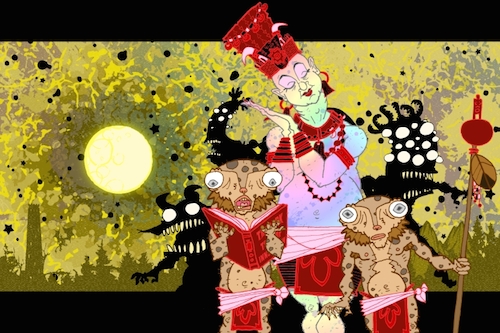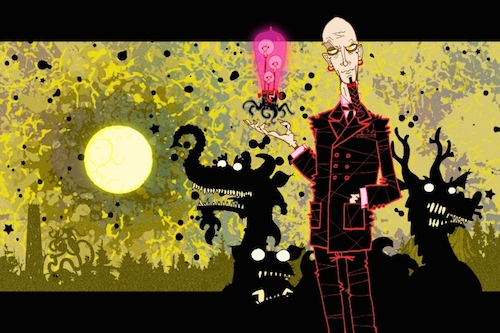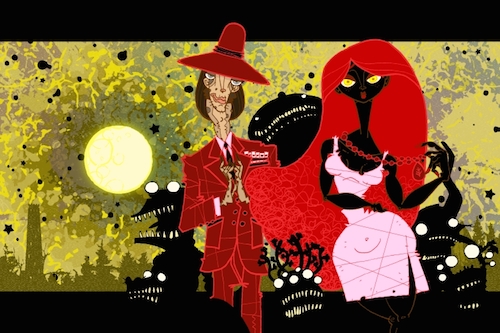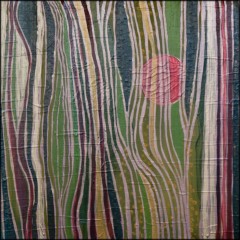Essays Poster Bot — March 1, 2016 10:47 — 1 Comment
Love For The Craft: The Weird Tales Of W.H. Pugmire
In the early 1970s Seattle’s seekers of the macabre were stalked by Count Pugsly, a ghoulish vampire lurking in the horror-filled chambers of Jones’ Fantastic Museum. 20 years later that same bogeyman could be seen, in drag, washing dishes and busing tables at The Cyclops Cafe. Today a portrait of the ghoul hangs on the cafe’s cyclopean walls and I asked a cyclopean waiter if he knew who the face in the portrait belonged to, “His name is Wilum-” he said, “I haven’t seen him in quite a few years, but I know he’s still around.” Wilum Hopfrog Pugmire is still around, he may not be clearing dishes from wobbly Formica tables, or haunting halls for wobbly teenage thrill-seekers, but he is haunting the dreams of horror fans & fiction lovers, as Seattle’s foremost Author of Lovcraftian fiction.
“Lovecraftian” is a genre of horror, incorporating a sense of the cosmic and the unknown. Wilum is well-known among fans of H.P. Lovecraft (the genre’s progenitor) as it’s Queen. He’s an openly gay Mormon and rarely seen in public without his unique brand of “Boy George drag.” We met at his childhood home in Rainier Valley, where he’d obviously been interviewed before, because before I had the opportunity to ask he started telling me about how being openly gay affected his relationship with the Mormon church. “I was excommunicated-” he said, “for 25 years. Then, about 11 years ago, I was able to return. I was re-baptized, but I don’t hold the priesthood and can’t go to the temple.”
Mormonism may not fully embrace Pugmire, but he fully supports the Mormon faith and in a round-about way, it was his devotion to faith that led to his interest in Lovecraft and career as an Author. “I went to Ireland as a Mormon Missionary-” he said, “I always lived for horror films and was crazy about going to theaters, but the Mormon leaders said, ‘No.’ We weren’t supposed to go to horror movies, we were ‘Ministers of Christ.’ So I said, ‘If you won’t let me go to horror movies, I’m going to start collecting paperbacks.'”
At the same time, Pugmire was pen pals with Robert Bloch, famed Author of Psycho and a correspondent of Lovecraft. “Bloch had a fondness for fans-” he said, “He was always willing to help and wasn’t a snob about it at all. Reading his fiction and being his pal really made me want to write.” While searching for books in Ireland, the young Missionary found an anthology featuring Lovecraft’s The Haunter Of The Dark, dedicated to Bloch. The dedication caught Wilum’s attention and the story captured his imagination… he had discovered the Cthulhu Mythos and quickly decided to become a Mythos Writer, or, more accurately, he decided to, “Dwell forevermore within Lovecraft’s titan shadow.”
Pugmire isn’t the only fan to fall under the Lovecraft spell. There are Mythos board games, plush toys, even tarot cards and every year (when the stars are right), people from all over the world flock to conventions where they can meet other fans, hear lectures and enjoy films featuring their favorite cosmic characters. I asked Pugmire about his first time at the Lovecraft Film Festival. His eyes drifted from mine, lit up and looked into space like a child staring at an imaginary jar of candy. “I was overwhelmed-” he said, “When I first saw the name H.P. Lovecraft, in big letters on that theater marquis, I was really excited.”
“Like a child” and “excited” are the perfect words to describe Pugmire’s adoration for his mentor. He’s in a perpetual alpha state… forever dreaming. When our interview was scheduled he offered to walk me through his “Lovecraft collection” and I assumed he meant Lovecraft swag, but what he really meant was books and when he showed me his books it was with the same precious sense of emotional investment that any child has for the treasures of a toybox. He spoke about Lovecraft’s work as though he were presenting a doll for Show & Tell. I asked if he had a favorite character. His eyes drifted away again, he smiled and said, “Nyarlathotep.”
Nyarlathotep is the probable favorite of every Lovecraftian Writer. Most fans are in love with Cthulhu (the colossal, bat-winged cephalopod), but most Cthulhu fans are drawn to the Mythos for its menagerie of weird creatures. Nyarlathotep is a man, who in Lovecraft’s words, “-came out of Egypt. Who he was, none could tell, but he was of the old native blood and looked like a Pharaoh.” The slender, swarthy Pharaoh first entered Lovecraft’s mind in a dream, in which he appeared as a kind of occult/scientific showman, arousing widespread fear with his public exhibitions, always buying “strange instruments of glass and metal” and combining them into “instruments yet stranger.” He’s also been described as a “faceless god,” or “crawling chaos” with “a thousand other forms” and other Authors have enjoyed expanding on those colorful descriptions, but Pugmire’s interest is more terrestrial, “He’s cool. He’s sinister. I like sinister guys because they’re kind of sexy. Kinky.”
Lovecraft left sex out of the majority of his work, but Lovecraft fans will find no lack of “kink” in Pugmire’s. He gave me one of his books, The Strange Dark One, a collection of shorts featuring some of the faceless god’s many avatars. There’s an undeniable sensuality to each of the stories and the passion doesn’t end with the prose. When I got the book home I noticed it had an almost overwhelming aroma, the scent of Viktor & Rolf’s Flowerbomb, Wilum’s preferred perfume…
Scent is just one of the many ways Pugmire explores sensuality. Many Authors write about what can be seen, heard, or touched, but Wilum describes smell, taste and even alludes to a sixth sense in his effort to express what he calls “The Outré.” In his words, “The brain triggers and records our senses. When we’re attacked by the weird or The Outside, it affects our psyche, our souls, as well as our flesh. The Outré is experienced through all our senses and can even trigger senses we don’t realize we have, leading to a different kind of awareness, of a reality that can’t be fully fathomed, but of which we can be vaguely aware.”
In literature, Lovecraft’s gift to human awareness was The Necronomicon, a catchall repository of arcane and cosmic knowledge. Pugmire’s gift to the Mythos is Sesqua Valley, a hidden pasture, nestled in the umbral wake of a twin-peaked mountain… slumbering beneath a dim sky and a yellow moon. “My aunt and cousins lived in North Bend. As I kid I’d spend time there and was always entranced by Mount Si. When I decided to write Lovecraftian fiction I remembered Ramsey Campbell, sending stories to August Derleth that were set in Arkham and Dunwich. Derleth said, ‘Create your own cities, in a setting you’re familiar with.’ Ramsey invented his British locations, so I thought I’d create a North West setting. Immediately, North Bend came to mind.”
Sesqua is inspired by North Bend. At first it was just a setting for typical Mythos stories, but as Wilum’s writing matured, it became home to his own original and enduring ideas. When asked if there was a map of it, Pugmire said, “There is no map of Sesqua. Its borders are fluid and in flux. Kinder to The Dreamlands.” In other words, the valley may have a physical location; you could point to it on a map, but if you could find your way to it you’d find it difficult to wander around in. Sesqua’s physical location is only where the valley starts. It’s a window, a door, or many doors, opening unto the many and limitless dreams of its Author.
In true Lovecraftian tradition some of those dreams are nightmares. I’ve been to Sesqua, through Pugmire’s work and recall winding paths that shift and fade like wicked children playing Hide & Go Seek. I was never alone, never chased, but always followed by a curious pack of formless shadows. I could taste the sweet, floral stink of the valley’s air and hear the lonely cry of some distant baying sound on the fragrant wind. My own dreams have been haunted ever since and in them, were the silver eyes of a race of toadish, wolf-like creatures… vicious in their innocence. Pugmire explained, “There is a shadow realm, a separate realm inhabited by these creatures and somehow they’ve found a way into our world. But they had to be led. The first person, or creature, who figured out how to cross over was Simon Gregory Williams.”
Simon is a Pugmire fan favorite, lovingly referred to as The Beast and based on one of Wilum’s old boyfriends. Wilum wouldn’t tell me the old flame’s name but did describe him, “He was a total asshole. A man I hated and despised who was also utterly fascinating and alluring.” I’d read about Simon, but admittedly only a little, which gave me the opportunity to ask dumb questions like, “What does he look like?” or, “What color is his hair?.” Like Robert Bloch before him, Pugmire was patient and all too happy to indulge me, “Simon’s hair, when long, is dark brown with streaks of deep red. When short, it’s hazel with streaks of copper. He’s one of The Shadow Children, a child of Sesqua. His features reveal, to the utmost, his inhuman quality. Therefore he is The Beast, because he’s totally inhuman and looks the part.” All The Shadow Children have the ability to camouflage their looks, but Simon glorifies in his grotesqueness and likes it when people are shocked by his monstrous face. He’s a snappy dresser, in a wide-brimmed hat, who I ultimately understood as a cross between Oscar Wilde and Doctor Faustus: collecting ancient tomes and worm addled grimoires, for his magic and malevolent practices.
Simon isn’t the only fan favorite, nor is he the valley’s only practitioner. There’s a red-haired woman in Sesqua named Marceline Dubois, a mortal Witch and relation to Nyarlathotep. “She re-acures in a lot of my stories-” Pugmire explained, “And her identity keeps changing in my imagination. I wanted to address the lack of women in Lovecraft and the lack of black characters.” Like the valley itself, Marceline’s description varies and is subject to the whim of her dreamer, but she’s consistently sexy and a reliable counterpoint to Simon’s masculinity. I asked Wilum if he’d ever defined her relationship to The Crawling Chaos. “No-” he said, “And I don’t want to. I like characters to be ambiguous. It helps them to grow in my imagination. As I write about her I’m discovering who she is. I don’t always want to understand my characters. I want to discover them as the reader discovers them.” I asked another wide-eyed fan question, “Is she good, or evil?” For the first time during our interview Pugmire’s childlike aura disappeared. He looked me straight in the eye and smiled sardonically, “She’s beyond good and evil.”
Pugmire’s writing is good and I confessed that although I’d been aware of him for years through his YouTube channel, like many Lovercraft fans I quickly changed the channel, asking myself who the weirdo in strange makeup was. I asked Wilum if he felt his look had ever held him back and he answered simply, “Yes.” Over the years he’s made dozens of videos, most of them starring a bizarre (if not outré) drag version of himself and since falling in love with his writing I’ve gone back to those videos, wondering why he’d create such an otherworldly public persona. I finally decided that the answer was in the question and that the key word was “otherworldly.”
The drag persona may not be the Writer, but it is a bridge to the insane world of the Writer’s mind. Pugmire’s vlog entries are like a one way mirror… the eyes on the other side are his own. He can see himself being insane and a good Writer has to be functionally insane to tread between the real world and the “other world” of dreaming. Mormons can’t drink their way into The Dreamland, but Pugmire can drag his way in and his dark designs are reflected in the silver eyes of Sesqua’s Children.
One Comment
Leave a Reply
The answer isn't poetry, but rather language
- Richard Kenney







Great article. Thanks for this.
2 questions:
Who is the artist for this article?
In the author’s opinion, is the scent of Sesqua Valley Wilum’s perfume?